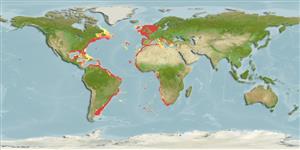Preferred temperature (Ref.
115969): 7.3 - 27.5, mean 13.9 (based on 3020 cells).
Índice de diversidade filogenética (Ref.
82804): PD
50 = 0.5001 [Uniqueness, from 0.5 = low to 2.0 = high].
Bayesian length-weight: a=0.01380 (0.01026 - 0.01858), b=2.99 (2.91 - 3.07), in cm Total Length, based on LWR estimates for this species (Ref.
93245).
Nível Trófico (Ref.
69278): 4.5 ±0.6 se; based on diet studies.
Resiliência (Ref.
120179): Baixo, tempo mínimo de duplicação da população 4,5 - 14 anos (Fec=60;).
Fishing Vulnerability (Ref.
59153): Very high vulnerability (90 of 100).
